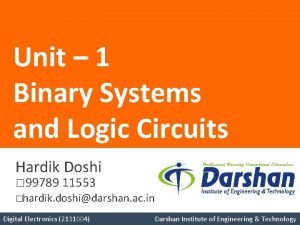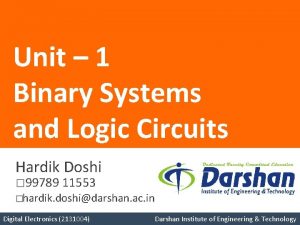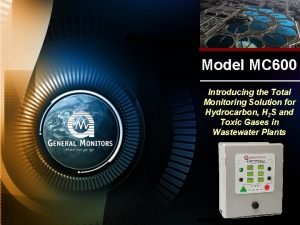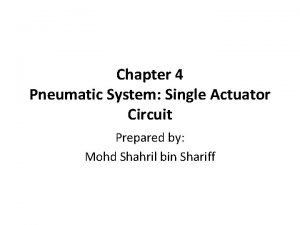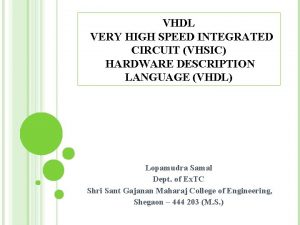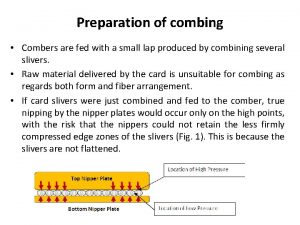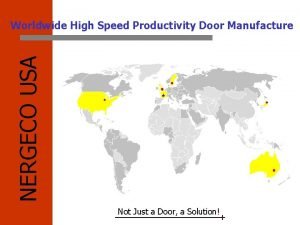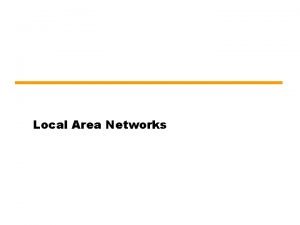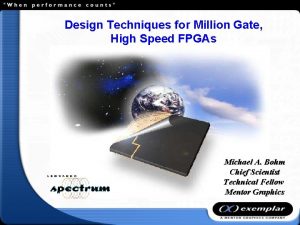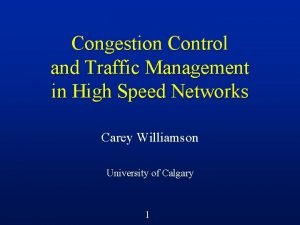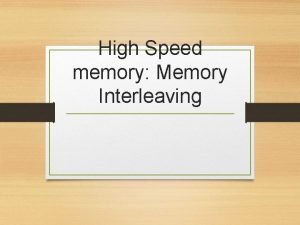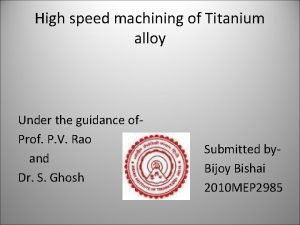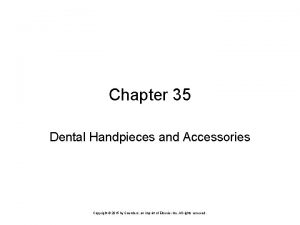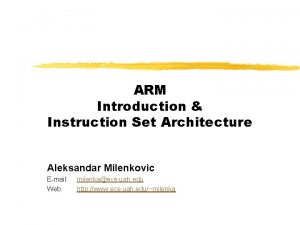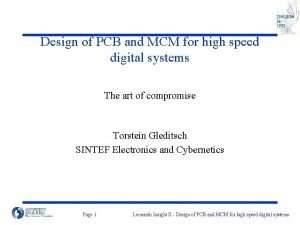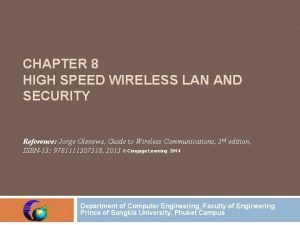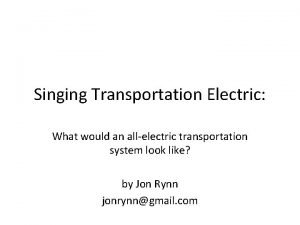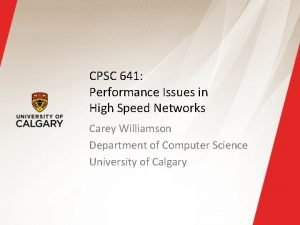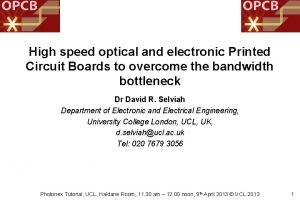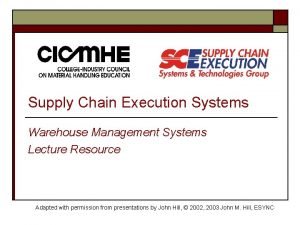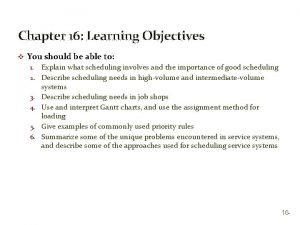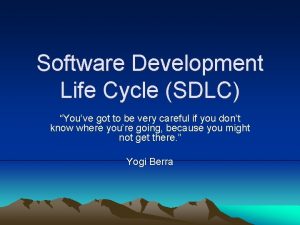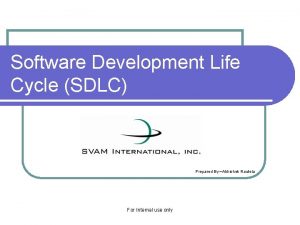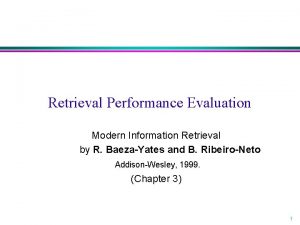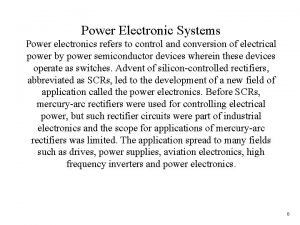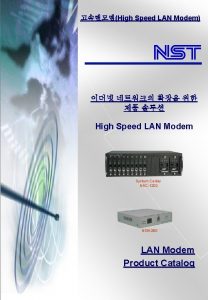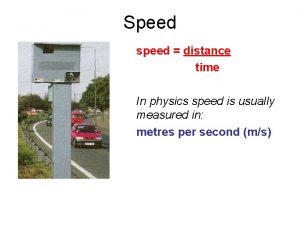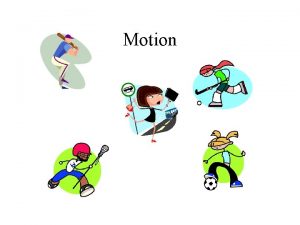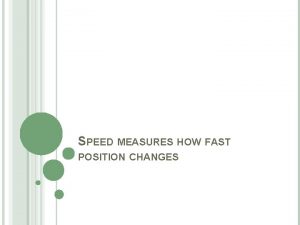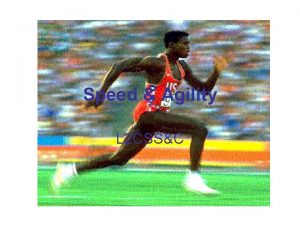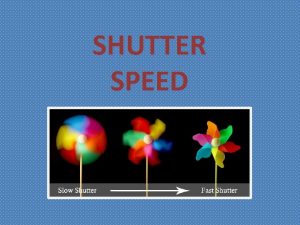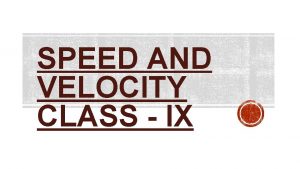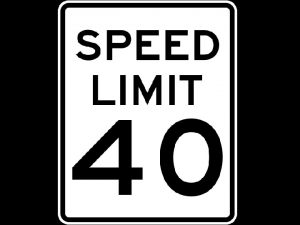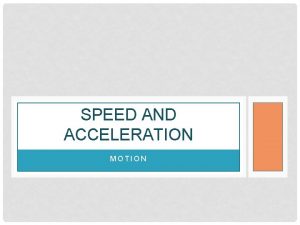High Speed Logic Power supply systems power supply













































































- Slides: 77

High Speed Logic Power supply systems power supply systems (v 8 b) 1

Part 1 High speed circuit power supply systems (v 8 b) 2

0. 1 Frequency / time relation • Basic facts and tools for the analysis of the edge of a clock – Rise time (Tr) = time to rise from 10% to 90% of the signal. V 90% 10% t Tr A slow rising edge A fast falling edge power supply systems (v 8 b) 3

0. 1 Knee frequency calculation Convert rise-time edge (Tr) and frequency (Fknee) • Fknee=0. 5/Tr • e. g. edge=5 ns, what is the equivalent frequency. • Fknee==0. 5/5 ns=100 MHz. Period/2=Tr Period of the equivalent signal power supply systems (v 8 b) 4

Analog / digital signal relation • Can a digital signal pass an analog circuit without distortion? • Use Fknee to quickly estimate if the signal can pass the clock edge or not. power supply systems (v 8 b) 5

Short term (edge) response by F_knee method Rising or falling edge= short term behavior Level 1 or 0 = long term behavior power supply systems (v 8 b) 6

Short term (edge) response by F_knee I L R A long wire or PCB trace • At high frequency, a wire becomes an inductor. Then a high frequency signal (fast edge) is attenuated (or distorted). • F_knee 0. 5/Tr , where Tr= rise time power supply systems (v 8 b) 7

Frequency response of a low pass trace • Shorter rise time pushes frequency requirement higher. Important results: – (1) A circuit has flat frequency response up to and including F_knee ( 0. 5/Tr) will pass the digital signal with rise edge (Tr). – (2) The behavior above F_knee of a digital circuit will have little effect on how it processes digital signals. – (3) Frequency lower than F_knee will affect the long term behavior of the signal. power supply systems (v 8 b) 8

How to apply the F_knee technique • Find or estimate Tr rise time of your signal. • Find F_knee 0. 5/Tr • Now whether your circuit can pass this signal or not depends on whether the circuit has flat frequency up to F_knee or not. power supply systems (v 8 b) 9

Example • Since F_knee =0. 5/Tr, Tr=0. 5/100 MHz • Hence Tr should not be shorter than 5 ns. • What would happen if Tr is shorter than 5 NS (e. g. 3 ns) ? Answer: distorted, edge smoothed This circuit has flat frequency response up to 100 MHZ 5 ns A PCB TRACE 3 ns The output of a 3 ns edge power supply systems (v 8 b) 5 ns 10

F_knee method is only an approximation • F_knee is only defined by the signal rise time and has no relation to other frequency domain parameters. It is easy to use and remember. • An imprecise measure of spectral contents, it cannot make precise prediction of circuit behavior. • Use Fourier transform if an accurate result is required. power supply systems (v 8 b) 11

Power exercise 1 • A circuit can pass signals of 200 MHz without distortion, what is the shortest rising edge that can pass this circuit? power supply systems (v 8 b) 12

0. 2 The horror of large d. I/dt • Since V =-L d. I/dt , L=inductance. • Since the traces are inductive, Large d. I/dt will create huge noise voltage V in the circuit. d. I/dt V Large d. I/dt creates large voltage V here power supply systems (v 8 b) 13

Speed d. I/dt problem • Logic families having minimum switch times much faster than the propagation delay suffer an unnecessary penalty in system design. Large d. I/dt creates problems. • Given two families with identical propagation delay statistics, the family with the slowest output switching time will be cheaper and easier to run. power supply systems (v 8 b) 14

Speed d. V/dt problems • Circuit response lower than Fknee may distort signal, circuit response higher than Fknee is not important in our design. • Shorter Tr (switch time) results in higher Fknee. So unnecessary short Tr is a problem. • So shorter Tr will not work in poorly designed circuits. • Shorter Tr will give larger d. I/dt, which will cause ground bounce. (will be discussed later) power supply systems (v 8 b) 15

How to find d. I/dt from d. V/dt • d. I/dt creates problems. • Since d. V/dt is easier to measure, so we try to find d. I/dt from V (output voltage change), Tr(rise time) and C(load capacitance). • We will show that • max(d. I/dt) =1. 52 V C/(Tr)2 power supply systems (v 8 b) 16

T 10 -90 Tr =rise time from 10 to 86 % Fig. 2. 14 of [1] Max slope is ( V/2)/(Tr/2) = V/Tr Max slope is ( V/Tr)/ (Tr/2)] =2 V/(T 2 r )---(i) ------------More precisely: consider voltage difference 0. 76* V (from 10 % to 86%) in equ. (i). Max slope is =0. 75*{2 V/(Tr 2)} 1. 52 V/(T 2 r ) T 10 -90 Tr Tr/2 power supply systems (v 8 b) 17

Showed two important relations • (1/R)max(d. V/dt)= (1/R) V/Tr • C*max(d 2 V/dt 2)=C*1. 52* V/(Tr)2 power supply systems (v 8 b) 18

Effect of d. I/dt at output and at power supply is similar d. I/dt is difficult to measure, so use d. V/dt easier estimate, it is easier Power supply V VL L to R C 1/T 2 r, big, more significant Tr 1/Tr, smaller so ignored power supply systems (v 8 b) 19

Max(d. Icapacitor/dt) 1/T 10 -902 Shorter Tr will give larger d. I/dt, which will cause ground bounce. VL • L Power supply Same d. I/dt R C Tr power supply systems (v 8 b) 20

Exercise 2 • Power supply V VL L R 5 V step C Tr 1 ns power supply systems (v 8 b) 21

Part 2 Power systems power supply systems (v 8 b) 22

Power system • Fixed and variable power supply – use 78 xx chip – Use power transistor 3055 • Use of opto-coupler • Use capacitors to stabilize power supply systems (v 8 b) 23

Fixed and variable Power supply • Use power supply chips 78 xx http: //eddie. dyec. com. tw/diy-demo/audio-diy/cd_dvd_modify/cd-100_2/cd 100_2 image/7805. jpg – E. g. 7805 for supper isolation to reduce interference 1 3 7805 7 V or above 2 200 u. F Fixed at 5 V, current limit 500 m. A • E. g. Variable power supply design and usage, e. g. step down 5 V --> 3 V. Input power V 1(5 V) R 1 R 2 TIP 3055 100 u. F power supply systems (v 8 b) Output=V 1[R 2/(R 1+R 2)] (0 -5 V) 24

Power exercise 3 Input power R 1 R 2 V 1 TIP 3055 Output=V 1[R 2/(R 1+R 2)] • If I have a power source 9 V and want to produce a power supply of 5 V, R 1=10 K. • Suggest two methods to achieve this. • Answer: power supply systems (v 8 b) 25

Example: Use of 7805 power stabilizer and opto isolator 7. 2 V • or above Power supply 8031 7805 Xilinx Optical Isolators 4 N 35 2 systems has no electrical linkage light Electrically Isolated 3 Volts battery Current driver circuit Low power Left/Right motors power supply systems (v 8 b) High power 26

Board level Power supply sys. • Power systems – provide stable voltage references – distribute power to all devices • We will learn about how to find – board level bypass capacitors – capacitor array • Examples and pictures are from Reference : High speed digital design by HW Johnson and Graham, Prentice Hall power supply systems (v 8 b) 27

Method (in single ended signaling) to reduce ground noise (low cost) for normal gates : return current is the same as the ground • Use better power distribution method: – Rule 1: Low impedance ground – Rule 2: Low impedance power (5 V) lines – Rule 3: Low impedance between power (5 V) and ground (0 V) -- use of bypass capacitors. power supply systems (v 8 b) 28

• Power Rule 1: Use low-impedance ground connections between gates -- use ground planes, power rails. • Reasons: – Fig. 8. 2 shows the hypothetical noise “N” in the ground loop, which is caused by the return current flowing through the ground inductance power supply systems (v 8 b) 29

• Power Rule 2: The impedance between power pins on the two gates should be as low as possible (fig. 8. 3) --use power planes, etc. Reasons: – common path inductance between power pins on any other gates is a problem even the ground is perfect. – If N is large, gate A may receive a lower power supply or reference voltage. power supply systems (v 8 b) 30

Voltage reference problems • Differential input= V 1 -N-R, • The ground wire has inductance and creates noise voltage N which should be as low as possible. (2. 5 V) power supply systems (v 8 b) 31

Power Exercise 4 (2. 5 V) • R (internal reference voltage is 2. 5 V) i. e. – gate_C_out =1(high) when the input of the gate C amplifier is positive – Else gate_C_out=0 (low) • Now V 1=2. 8 V, R (internal reference voltage is 2. 5 V, • What is Gate_C_out when • (i) noise N=0? • (ii) noise N=0. 5? • (iii) Why there is noise N? power supply systems (v 8 b) 32

• Power Rule 3: There must be a low-impedance path between power and ground (fig. 8. 4)-- use by- pass-capacitors. • Reasons (Fig 8. 3): – The return current flows thru. the battery should create a voltage drop as low as possible to maintain a good reference. The impedance of the battery must be low. – By pass capacitors provide such low impedance paths. Lpcable=100 n. H Perfect Power supply Ltot=N number of LC 3 in parallel C 3 Cap. array Board bypass LC 2 C 3 capacitor C 2 power supply systems (v 8 b) 33

Use of power, ground planes and capacitor array Rule 3 Rule 2 Rule 1 power supply systems (v 8 b) 34

Power system design techniques: Multi-layer Power distribution • Power supplies designed and sold usually have very low output impedance. • But the wiring to the board and devices may contain inductance. • To maintain a stable power to the circuits we have to solve it in 3 different levels: – Power distribution wiring – Board level filtering – Local filtering at individual integrated circuits power supply systems (v 8 b) 35

Level 1: Power distribution wiring • Resistance of power distribution wiring. – Resistance proportional to inverse diameter wire, 40% increase of wire diameter reduces resistance by 1/2. – Sense wire in new power supply designs corrects for resistance in power distribution wiring ( http: //reprap. org/bin/view/Main/PCPower. Supply) • Inductance, a more difficult issue. (Section 8. 2. 1) – Use low-inductance wiring -- wide-flat wires. – Use differential logic Fig. 8. 6 (not economical) – Reduce power supply current change can minimize the effect of inductance -- using by pass capacitors. power supply systems (v 8 b) 36

Level 2 : Board level filtering • Fig. 8. 7, switching at output of gate A can create a large current change through the power supply. • For a 1 ns edge (at high frequency) , the inductance blocks the current from the power supply to gate A. • Add C 2 (board level by pass capacitor) in fig. 8. 8 to reduce the Water current passing through the inductance. tanks • Example 8. 1 shows how to calculate the value of the board level by pass capacitor. This capacitor Cboard_bypass provides low impedance up to a Power-System-Wiring frequency FPSW. In Germany Mannheim power supply systems (v 8 b) 37

Demo • By-pass capacitor 10 u. F + Youtube TX (Clean) TX (Noisy) Vcc (Clean) Vcc (Noisy) No by-pass capacitor power supply systems (v 8 b) using by-pass capacitor 38

A PC mother board with board level by-pass filter (use parallel capacitors to make a big one: reduce leg inductance; save size and cost) Board level by-pass capacitors(C 2) Power supply and cable power supply systems (v 8 b) 39

C 2 to be added power supply systems (v 8 b) 40

Level 3: Local filtering at individual integrated circuits • However no capacitor is perfect, LC 2 (at the legs of by pass capacitor C 2) may cause its impedance to rise at high frequency. • The best way to get very low inductance is to use a lot of parallel small capacitors. • Use capacitor array to reduce the problem of LC 2 at high frequency. • See Example 8. 2 power supply systems (v 8 b) 41

Analogous to the water delivery system • Power supply or Board level By Capacitor e. g. 10 u. F-200 u. F Capacitor Array e. g. 0. 01 u. F e. g. 10 u. F-200 u. F power supply systems (v 8 b) 42

Multi-level by pass capacitors design • • Power supply -> Example: Fpsw below 159 KHz board --> individual Ics Fboard Fc_array 159 K->3. 18 M->Fknee 10 u-1000 u. F 32 x 0. 016 u. F • A power supply provides low impedance at low frequency. • Board level by pass capacitors provide low impedance at higher frequency • Parallel a lot of small capacitors provide very low impedance up to a very high frequency Fknee(e. g. edge=5 ns, Fknee=0. 5/Tr=0. 5/5 ns=100 MHz). power supply systems (v 8 b) 43

Power supply bypass capacitor design • Design calculations, find power supply systems (v 8 b) 44

Revision of important formulas (Remember them!!!!) • Impedance of C at freq. • Impedance of L at freq. – current passing thru. a capacitor with changing voltage – voltage across an inductor with changing current • Also when impedance is in terms of Fknee: power supply systems (v 8 b) 45

Level 1 - Power distribution lines • Board level by pass capacitor(C 2) design Cap array(C 3) 0. 1 ~ 1 u. F Vcc Power supply Ground Board level electrolytic bypass capacitor 10~500 u. F Digital circuit board power supply systems (v 8 b) 46

Level 2 - bypass capacitor design • Board level by pass capacitor (C 2) design Vcc Power supply Cap array (c 3) 0. 1 ~ 1 u. F Ground Board level electrolytic bypass capacitor 10~500 u. F Digital circuit board power supply systems (v 8 b) 47

Capacitor array C 3 (a number of surface mounted capacitors) Old type power supply systems (v 8 b) 48

Capacitor array C 3 (a number of new type surface mounted capacitors) Old type power supply systems (v 8 b) 49

Board level filtering calculations Why board level by-pass cap. C 2 is needed? • power supply systems (v 8 b) 50

Procedure for level 2 (board level) calculation • 2 -1. First find out the maximum change of current the circuit demands. • 2 -2. Then find the maximum tolerated impedance of the inductor • 2 -3. Find at what signal frequency (or edge using Tr=0. 5/Fknee) this inductor has too much impedance • 2 -4. Find the value of the required bypass cap. C 2 power supply systems (v 8 b) 51

Given: N=100 gates, C=10 p. F load in t =5 ns, supply voltage= E, inductance Lpcable= 100 n. H • Step 2 -1: find max. change of current the circuit demands • Assume max. tolerable noise EN=0. 1 Volts • Perfect 5 V power supply Maximum noise allowed=0. 1 V Digital circuit, Lpcable=100 n. H when 100 gates are impedance <0. 1 switching draws 1 A Ground power supply systems (v 8 b) 52

Additional Explanation • Dear professor, • In the previous slide, we computer the maximum current change is 1 A, then we use ohm’s law to calculate the impedance. But I am confuse that if we use the max current change to calculate, the result should be minimum impedance since the noise En is fix. So impedance should larger than 0. 1 ohm. • Answer: Thanks for your question and I think it is a very good question on this topic. For your query, I think it is a naming problem; the explanation of calling it Xmax is as follows: – We set the noise allowed (by noise margin) to be En=0. 1 Volts. If the total required current is 1 A – The max impedance is Xmax=En/1 A=0. 1 Ohms. You are right to say that if the required current is less, say 0. 9 A, Xmax will be 0. 1/0. 9=1. 111 Ohms, it is higher than 0. 1 Ohms. Then how can I say this is called Xmax. The reason is we call it Xmax because it is the X allowed for that situation, and you cannot allow a higher impedance X in the circuit, that means when I=0. 9 A, your Xmax is 0. 11 Ohms. – Or in my original slide , when I=1 A, Xmax is 0. 1 Ohms. – Using another example, if the current is I= 1. 1 A (higher than 1 A), En=0. 1 is not changed because it is coming from the noise margin (you don’t want noise to be higher than that in your circuit) , Xmax=En/I=0. 1/1. 1=0. 09 Ohms, so in this case Xmax is 0. 09 Ohms. That means when you design a circuit, you cannot allow impedance inside the circuit higher than 0. 09 Ohms. power supply systems (v 8 b) 53

Step 2 -2: • Assume max. current change=1 A, so I= from 0 A to 1 A is 1 A • Impedance XLof power cable Lpcable • = EN / I = 0. 1 Perfect 5 V power supply Maximum noise allowed=0. 1 V Digital circuit, Lpcable=100 n. H when 100 gates are impedance <0. 1 switching draws 1 A Ground power supply systems (v 8 b) 54

power supply systems (v 8 b) Step 2 -3: Find at what signal frequency the inductor has too much impedance • (At a very slow edge, the power source is blocked by the inductor, let alone Tr=5 ns that the circuit demands) Perfect 5 V power supply Maximum noise allowed=0. 1 V Digital circuit, Lpcable=100 n. H when 100 gates are impedance <0. 1 switching draws 1 A 55 Ground

Photos of the board and caps(board C 2 and Cap array C 3). Local filtering Cap array C 3 0. 1 ~ 1 u. F • Vcc Power supply Ground Board level Electrolytic C 3 bypass capacitor 10~500 u. F Digital circuit board power supply systems (v 8 b) 56

Step 2 -4: Find board level by-pass cap. to give an alternative power path at high freq. • At what freq. Lpcable is too large(>0. 1 )? • Below this Fpcable frequency, the power supply unit can supply current; above this the bypass C 2 can supply current. XL=2 FL power supply systems (v 8 b) 57

Level 3 Local filtering • It is needed because of the inductance at the legs of the board level bypass capacitor • Local filtering using capacitor array power supply systems (v 8 b) 58

Level 3 - Local filtering • Board level by-pass capacitor C 2 design Vcc Power supply Local filtering C 3 Ground Board level electrolytic bypass capacitor 10~500 u. F Digital circuit board power supply systems (v 8 b) 59

When Freq. >159 KHz, the power supply cannot supply current When freq. >159 KHz, the paths are cut off by the large impedance Lpcable=100 n. H Perfect Power supply Digital circuit Board bypass capacitor C 2 =10 u. F LC 2=5 n. H • But when freq. is too high, the inductance at bypass cap C 2 may have problems. See next power supply systems (v 8 b) 60

But the board level by-pass cap has inductance 5 n. H at its legs • The maximum impedance at legs is 0. 1 , so that noise is controlled under 0. 1 V. • So when freq. is higher than 3. 18 MHz, the legs of the by-pass capacitor will block current flow, so use an array of small capacitors to supply current. Low freq, get power from power supply Mid. freq. Get power High freq. Get power from board level cap. from cap. array F 1 =159 KHz power supply systems (v 8 b) F 2=3. 18 MHz 61

When Freq. F 2 >3. 18 Mhz, the board bypass cap. cannot supply current • Freq. When freq. F 2 >3. 18 MHz, these paths are cut off by the large impedance Lpcable=100 n. H Perfect Power supply LC 2=5 n. H Board bypass capacitor C 2 Digital circuit power supply systems (v 8 b) 62

Level 3 Design procedures • Step 3 -1: Find the highest (F 3 ) frequency of the system based on Tr 3 (e. g. 5 ns). • Step 3 -2: Find (Ltot 3) total inductance tolerated. • Step 3 -3: Find (N) total number of cap used for the cap. array for the given serial inductance of each capacitor element. (e. g. 5 ns). • Step 3 -4 : Find (C 3) the minimum value of each Cap. array element. power supply systems (v 8 b) 63

power supply systems (v 8 b) Capacitor array number N calculations Ltot 3=Max. tolerable induct. for all array capacitors Xmax= Max. tolerable impedance for all array capacitors • Step 3 -1: Find highest F 3 frequency: comes from clock edge 5 ns , therefore Lpcable=100 n. H Perfect Power supply LC 2=5 n. H Board bypass capacitor C 2 Ltot 3=LC 3/32 (in parallel) C 3 Cap. array C 3 Ctot 3 64

power supply systems (v 8 b) Capacitor array number N calculations Ltot 3=Max. tolerable induct. for all array capacitors Xmax= Max. tolerable impedance for all array capacitors • Step 3 -3: Find N • We will use an array of capacitors to provide alternative power source at high freq. • Given LC 3=5 n. H (legs of each small caps. C 3). Lpcable=100 n. H Perfect Power supply LC 2=5 n. H Board bypass capacitor C 2 Ltot 3=LC 3/32 (in parallel) C 3 Cap. array C 3 Ctot 3 65

Step 3 -4 Find (C 3): the minimum value of each Cap. array element • Again Xmax=0. 1 to provide current to gates, • Find minimum C 3 value to do the job so use F 2=3. 18 MHz (lower side) Ctot 3=32 C 3 in parallel power supply systems (v 8 b) C 3 Cap. array C 3 Ctot 3 66

Note: Verify that when F 2=3. 18 MHz or T 2=157 ns, • T 2=157 ns is the clock edge limit when LC 2 blocks the current. • (LC 2 pathway) • Or XC 3_array • (Ctot 3 pathway) X XLC 2 0. 1 F 2 s=3. 18 MHz power supply systems (v 8 b) 67

Overall impedance X and Freq. plot • Current from power supply XC 2 Current from C 2 XC 3_array Xpcable No current Current from Cap. Array C 3 demand here XLC 2 XLtot 3 X 0. 1 See next slide F 1=159 KHz 3. 18 MHz power supply systems (v 8 b) 100 MHz 68

A summary of the steps : 1) Based on power line inductance, find max impedance Xmax 2) Based on Xmax, find the lowest effective freq. (F 1) of the board-level bypass cap (C_bypass) 3) Based on F 1, find C_bypass value. 4) To solve the problem caused by legs of C_bypass using capacitor array (C 3_array). a) b) Find the minimum number (N) of array elements needed based on the inductance of the legs of elements in C 3_array, and the maximum required frequency inside the board. From N find the value of individual element of C 3_array (C 3) 5) Plot the frequency response curves of the whole span of frequencies. power supply systems (v 8 b) 69

Power exercise 5 • A hardware system has 500 digital outputs, each output is switching a 10 -p. F load at 5 ns. • The power comes from a perfect voltage source of 5 V via a power cable of inductance 200 n. H. • The maximum allowable supply voltage drop within the system is 0. 1 V. • The series inductance of each capacitor (for all types) is 5 n. H. Ignore the inductance of the traces in the system board. State any assumptions you used in the calculations. • Find board level bypass capacitor C 2 • Find the number N of elements in the capacitor array and its individual value C 3. power supply systems (v 8 b) 70

Power Exercise 6 • • – • A large PCB board contains two circuit areas groups, A and B. The overall power comes from a perfect voltage source of 5 Volts. The maximum allowable supply voltage drop anywhere in the board is 0. 1 Volts. Given that d. I = |C (d. V/dt)|, for d. I is the change in current, C is the capacitance of the capacitor and d. V/dt is the rate of change of the voltage. The board level bypass capacitors for serving both group A and B have a very small series inductance. State any assumptions you used in the calculations. Three large board level by-pass capacitors are provided, how do you place them? Copy the following diagram to your answer book and insert the bypass capacitors in your diagram. Calculate the values required? Show your calculation Power cable with inductance =150 n. H Power supply + Circuit trace with inductance=35 n. H A large PCB Ground Circuit trace with inductance=60 n. H power supply systems (v 8 b) Circuit group A: · 100 outputs ·each output has a capacitive load of 10 p. F. ·switching time is 10 ns Circuit group B · 120 outputs ·each output has a capacitive load of 5 p. F. ·switching time is 15 ns 71

Appendix Answers to exercises power supply systems (v 8 b) 72

Q&A on capacitor array C 3 Cap. Carray Ctot 3 3 • Should the impedance of inductance XLtot 3 and capacitance XCtot 3 (both are 0. 1 ) be added together since they are in series? (The total equivalent Ctot 3=0. 5 u. F, LCtot 3=5 n. H/32) • Ans: Yes they should be added together. But at 3. 18 MHz, XLtot 3(3. 18 MHz) =2 3. 18 M (5 n. H/32) 3 x 10 -3 (very low), while XCtot 3(3. 18 MHz) = 1/[2 3. 18 M (0. 5 u. F)] 0. 1 . • On the other hand at 100 MHz, XLtot 3(100 MHz) = 2 100 M (5 n. H/32) 0. 1 while X Ctot 3(100 MHz) =1/[2 100 M (0. 5 u. F)] 3 x 10 -3 is low. • So between 3. 18 MHz and 100 MHz, when XC and XL are added they will not be too much larger than 0. 1 . power supply systems (v 8 b) 73

Answers: • Answer 1: – Tr=2. 5 ns. • Answer 2: – (i) noise N=0? Ans: 2. 8 -0 -2. 5=0. 3 positive, gate. C out 1 – (ii) noise N=0. 5? Ans: 2. 8 -0. 5 -2. 5=-0. 2 V neg. so gate. C out is 0 (ii) Why there is noise N? ans: ground loop, long wire • Answer 3: – Exercise: When gate A is on , N=0. 5 V , what is Vdiff? ANS: V 0=2. 5(FIXED), V 1=2. 5: v 0+v 1 -(V 0 v 1)=2. 5+2. 5 -(2. 5 -2. 5)=5 V, N has no effect – Exercise: When gate A is off , N=0. 5 V, what is Vdiff? ANS: V 0=2. 5(FIXED), V 1=0: v 0+v 1 -(V 0 -v 1)=2. 5+0(2. 5 -0)= 0 V, N has no effect • Answer 4 : (verified on 29 March 2016) – – • Board level bypass capciator(C 2)=500 u. F Capacitor array totoal=C_total_array=12. 5 u. F Number o capacyor in the cap. Array(N)=157 Each element of the cap. array is. C 3 = 0. 079 u. F. Answer 5 : – C 1=7. 3 u. F – C 2=0. 875 u. F – C 3=0. 24 u. F power supply systems (v 8 b) 74

Appendix • power supply systems (v 8 b) 75

Alternative method (differential signaling) to reduce ground noise (expensive) by using differential logic gates and transmission lines • • • Gate C sees V_diff V 0=2. 5 (fixed), When a gate is on, V 1 =2. 5 else V 1=0 A method to remove ground connection noise Differential signaling logic uses 3 wires (2 signals plus ground) to connect a stage to the next, while the usual non-differential signaling logic uses 2 wires (signal + ground) only. V 1 V 0 =2. 5+V 1 =2. 5 -V 1 power supply systems (v 8 b) 76

Signal propagation http: //en. wikipedia. org/wiki/Differential_signaling • power supply systems (v 8 b) 77
 What is fringe vision when driving
What is fringe vision when driving First order logic vs propositional logic
First order logic vs propositional logic First order logic vs propositional logic
First order logic vs propositional logic First order logic vs propositional logic
First order logic vs propositional logic Combinational logic vs sequential logic
Combinational logic vs sequential logic Cryptarithmetic problem logic+logic=prolog
Cryptarithmetic problem logic+logic=prolog Project management plan example
Project management plan example Majority circuit
Majority circuit Combinational logic sequential logic 차이
Combinational logic sequential logic 차이 If x = 0 and y = 1, which output line is enabled?
If x = 0 and y = 1, which output line is enabled? How to calculate speed with time and distance
How to calculate speed with time and distance Speed detection of moving vehicle
Speed detection of moving vehicle Flex28024a
Flex28024a Binary systems and logic circuits
Binary systems and logic circuits Binary systems and logic circuits
Binary systems and logic circuits Logic supply mc600
Logic supply mc600 Indirect control of single acting cylinder
Indirect control of single acting cylinder Value innovation the strategic logic of high growth
Value innovation the strategic logic of high growth Vhsic
Vhsic High speed combers
High speed combers Nergeco doors
Nergeco doors High speed lans
High speed lans Easterlies and westerlies trade winds
Easterlies and westerlies trade winds Ti high speed adc
Ti high speed adc High speed fpga design
High speed fpga design High speed traffic management
High speed traffic management Acn internet canada
Acn internet canada What is memory interleaving
What is memory interleaving High speed machining titanium
High speed machining titanium The high speed handpiece uses burs
The high speed handpiece uses burs 3 stage pipeline arm organization
3 stage pipeline arm organization Acn tech support
Acn tech support Midwest high speed rail association
Midwest high speed rail association Pcb
Pcb High speed wireless lan
High speed wireless lan City-region
City-region Djordjevic-sarkar
Djordjevic-sarkar Oslo to stockholm high speed train
Oslo to stockholm high speed train High speed networks
High speed networks Semi high speed
Semi high speed Ion pumps in the pumping speed range 150 to 1000 l/s
Ion pumps in the pumping speed range 150 to 1000 l/s Pcb high speed
Pcb high speed High speed chapter 7
High speed chapter 7 High speed machining definition
High speed machining definition Salishan conference on high speed computing
Salishan conference on high speed computing Local winds and global winds
Local winds and global winds Acninc com products
Acninc com products Power triangle diagram
Power triangle diagram Binet scale
Binet scale Decision support systems and intelligent systems
Decision support systems and intelligent systems Principles of complex systems for systems engineering
Principles of complex systems for systems engineering Embedded systems vs cyber physical systems
Embedded systems vs cyber physical systems Elegant systems
Elegant systems Chapter 14 water supply systems
Chapter 14 water supply systems What is a supply chain execution system
What is a supply chain execution system Scheduling ahead from a point in time.
Scheduling ahead from a point in time. High security fencing trinidad
High security fencing trinidad Adaptive sdlc
Adaptive sdlc Sdlc vs slc
Sdlc vs slc Chapter 5 section 1 supply
Chapter 5 section 1 supply Ang pagbabago sa suplay ay dahil sa
Ang pagbabago sa suplay ay dahil sa Matching supply with demand
Matching supply with demand High precision vs high recall
High precision vs high recall High precision vs high recall
High precision vs high recall Supportive behavior
Supportive behavior High expectations high support
High expectations high support High precision vs high accuracy
High precision vs high accuracy High directive and high supportive behavior
High directive and high supportive behavior Pengertian investasi
Pengertian investasi Ibm power systems technical university
Ibm power systems technical university Cyberpower headquarters
Cyberpower headquarters Aix smit
Aix smit Ibm geographically dispersed resiliency for power systems
Ibm geographically dispersed resiliency for power systems Storage for ibm power systems
Storage for ibm power systems Hamilton sundstrand power systems
Hamilton sundstrand power systems Center for power electronics systems
Center for power electronics systems Esl power systems jobs
Esl power systems jobs Power electronic systems
Power electronic systems













